If browsing speed is important to you—and it should be—you'll probably be interested to know that there are ten simple flag modifications you can make in Google Chrome in order to achieve the fastest browsing speed possible.
A few months ago, Dallas covered six ways to speed up the Chrome mobile browser on a Nexus 5, and if they're good enough for his Android phone, they're good enough for our desktops. Below, I'll show you how to enable them, along with a few other speed-increasing tips.
Step 1: Access Chrome's "Secret" Settings
Chrome allows you to use unofficial browser features called "flags" while they are being tested or are generally unstable. These features are strictly experimental and may break or disappear at any time. In other words, take advantage of them while you can.
To access these secret settings, simply enter chrome://flags into your address bar, aka the omnibox, which we've hacked a couple times over the last week to make a tab-based text editor and speed up our Gmailing. Hit the Enter key, and you will be brought to the flags page and shown a short warning.

It's okay. These features can all be disabled later if you notice any glitches.
Step 2: To Make Things Simple, Open "Find…"
These flags aren't very organized, so to save you from scrolling up and down all day, hit Cmd+F (Mac) or Ctrl+F (Windows), or click the three-line overflow menu button in the upper-right and select "Find…".
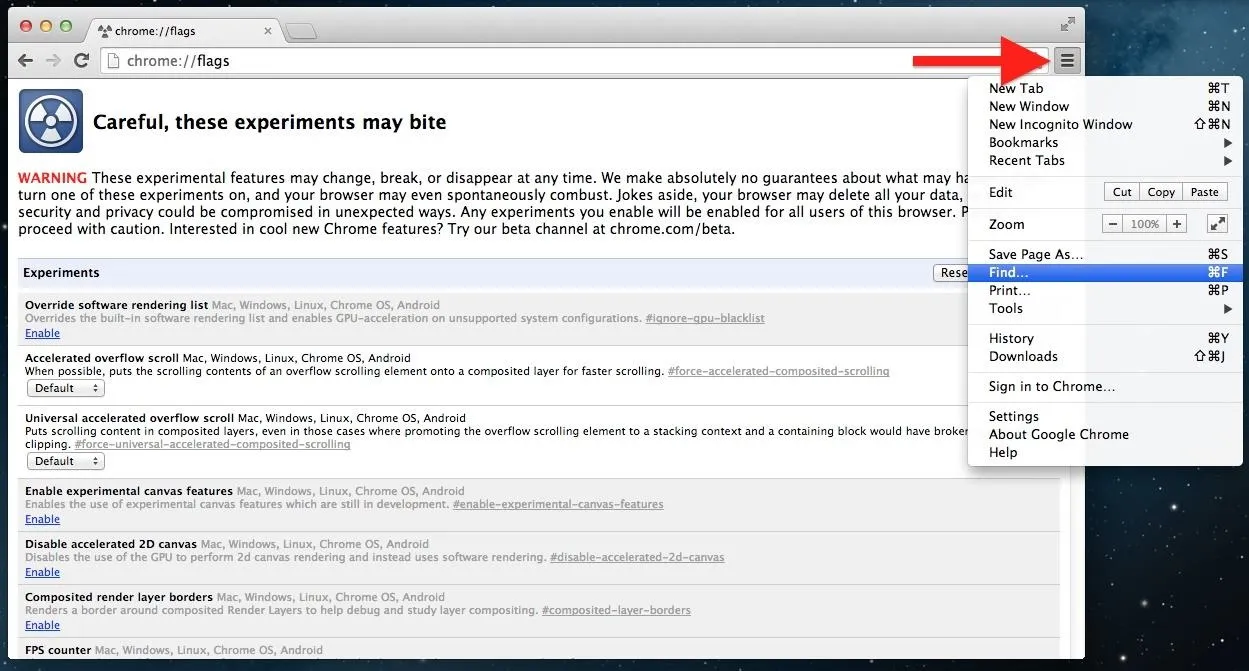
Step 3: Pick & Choose Your Chrome Speed Hacks
Now, below are ten different settings you can mess with in Google Chrome, but you don't need to enable all of them. Pick and choose the ones you want, and find the combination that works best with your workflow. Some things may not apply to your particular browsing game.
Speed Tip #1: Set "Maximum Tiles" to 512
The first feature we're going to change is the number of "maximum tiles for interest area." Basically, this feature will increase the RAM that Chrome is allowed to use, and should take any little glitch out of your browsing experience.
In the search bar that you just opened in Step 2, type Maximum Tiles and hit Enter. Once you're brought to the Maximum Tiles row, click the drop-down menu and change Default to 512.
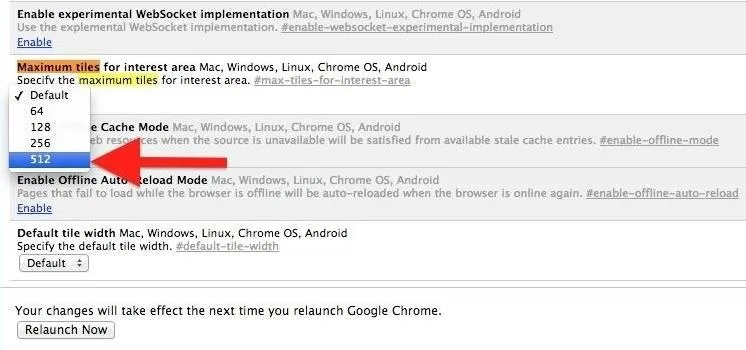
Speed Tip #2: Change the Number of Raster Threads to 4
Tired of slow loading image? This modification will change the rendering speed of images in Chrome. Search for Number of Raster, and change the number of raster threads to 4.

Speed Tip #3: Enable SPDY/4
This modification will speed up page loading by making web transactions quicker. Search for Enable SPDY, then click the little blue Enable link in the Enable SPDY row; its color should change from light grey to white and the blue link should now say "Disable."
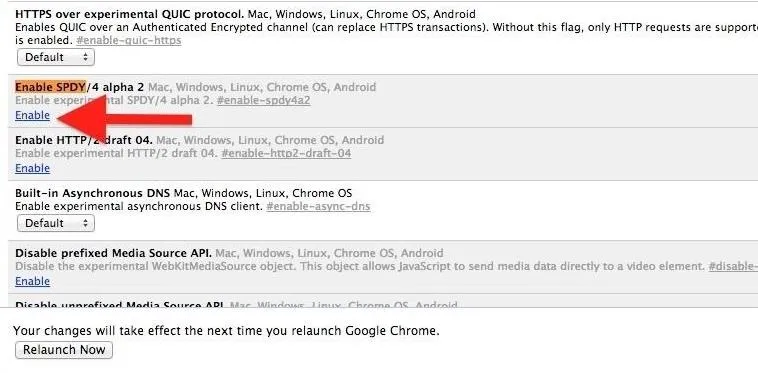
Speed Tip #4: Enable Offline Cache Mode
For moments where internet connectivity is briefly interrupted, you can allow Chrome to load cached versions of webpages. Search for Enable Chrome and click the Enable link in the Offline Cache Mode row.

Speed Tip #5: Enable Experimental Canvas Features
This modification allows Chrome to utilize opaque canvases to increase loading times and boost performance. Search for Enable Experimental Canvas and click Enable in the Experimental Canvas row.
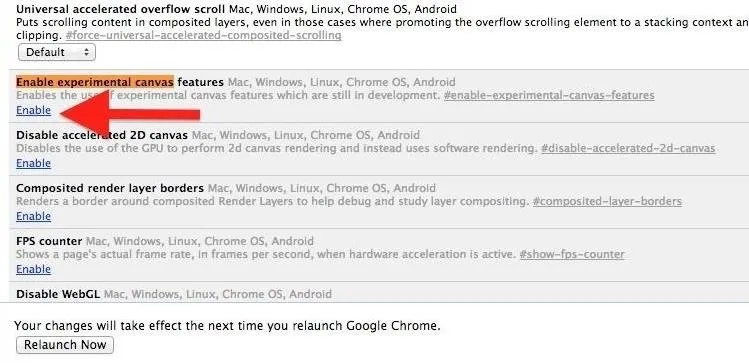
Speed Tip #6: Enable Experimental Websocket Implementation
This feature provides a different way to deal with web traffic communication. Search for Experimental Websocket and click Enable.

Speed Tip #7: Enable Touch Events
Chrome isn't so hot on touchscreens. If you're using an iPad, Microsoft Surface, or some other touchscreen computer, this will dramatically improve Chrome's performance. Search for Touch Events and select Enable.

Speed Tip #8: Enable Accelerated Overflow Scroll
This will provide a better scrolling experience on particularly long pages. It works by compiling content into a single layer when it would otherwise be presented to you as in an overflow. Search for Accelerated Overflow and change to Enable.
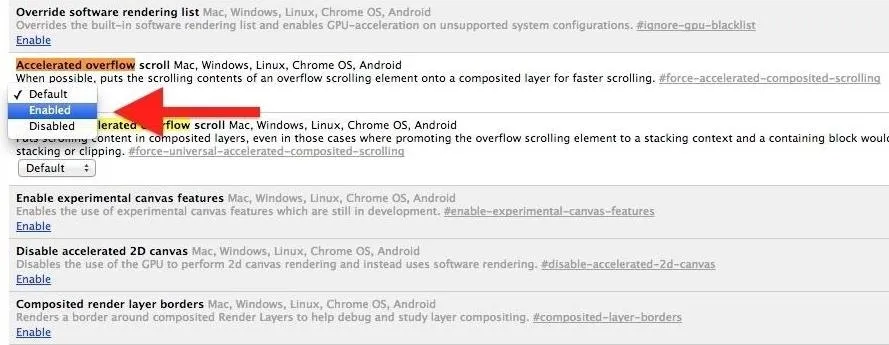
Speed Tip #9: Enable Fast Tab/Window Close
If you can't close a window or tab fast enough, try enabling the Fast Tab flag. This will get content out of your face faster than ever by running Chrome's JavsaScript handler independent of the graphical user interface (GUI). Search for Enable Fast Tab and select Enable.

Speed Tip #10: Enable Checking for Conflicts with 3rd Parties
This only works on Windows, but it's pretty useful. There's nothing worse than a browser crashing in the middle of something important, so this option will run a background check to warn you if software is discovered that may crash the browser. Search Conflicts with 3rd Parties and Enable it.

Step 4: Relaunch Chrome
In order for these changes to take place, you'll need to relaunch Chrome. At the bottom of the chrome://flags page, you will notice a "Relaunch Now" button—click it, and enjoy your speedy browsing upon opening Chrome.

What speed-increasing flags do you find most useful? Share below!
Cover image via Shutterstock




Comments
No Comments Exist
Be the first, drop a comment!